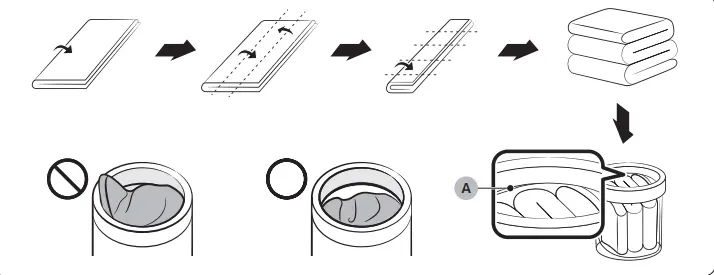Samsung WA50R5400AW Washer User Manual: Start Smart & Keep Your Laundry Fresh
Looking for the Samsung WA50R5400AW Washer User Manual? This easy-to-understand guide helps you get started quickly and use your top-load washing machine like a pro. In the manual available below , you’ll find detailed instructions for initial setup, choosing the right detergent, laundry tips to keep your clothes fresh and clean, troubleshooting common issues, and maintenance advice to keep your washer running smoothly.
Whether you’re a new user or want to get the most out of your Samsung washer, this manual provides practical steps to save time, reduce energy consumption, and achieve the best washing results every time.
How to Use a Washing Machine: Complete Guide for Cleaner Clothes and a Healthier Machine
Getting fresh, clean clothes and keeping your washing machine running smoothly isn’t just about pressing “Start.” A few extra steps before and during washing can make all the difference. Here’s a comprehensive, easy-to-follow guide that will help you achieve the best performance from your washer while protecting your clothes from damage.
Step 1: Calibrate Your Washer:
Before your first load—or if your washer seems to be struggling with weight detection—run a quick calibration. It helps the machine sense the correct laundry weight for more accurate washing cycles. To do this, ensure the tub is empty, then turn the machine on by pressing the Power button. Press and hold the Temp. And delay the End buttons together for three seconds.
After that, press and hold the Start/Pause button until the drum begins to spin in both directions clockwise and counterclockwise, for about a minute. WOnce calibration finishes, the display will show ‘0’ and the washer will shut down on its own. Now you’re ready to start using it properly.
Step 2: Proper Laundry Sorting:
Sorting your laundry is essential for cleaner results and to prevent fabric damage. Always separate items by fabric type—group cotton, synthetics, silks, wool, and rayon separately.Then, separate clothes by color to prevent colors from bleeding—keep whites apart from colored items. It’s also good practice to mix large and small items to create balance during spinning. Lastly, sort by sensitivity. Wash delicate items like silk or fine wool on a separate gentle cycle, and always check the care labels before throwing anything in the washer.
Step 3: Check Pockets and Prepare Clothes:
Before you add laundry to the drum, check all pockets for coins, pins, keys, or any metal objects—they can damage both the clothes and the washer. To protect decorative details like embroidery, buttons, or delicate stitching, turn the garments inside out before washing. Make sure all zippers are closed to prevent scratching the tub and tie any loose strings or cords to avoid tangling during the wash.
Step 4: Use Laundry Net for Delicates:
Using a laundry bag is essential for protecting delicate garments. Items like bras (especially with metal underwires), lace lingerie, nylon stockings, or anything lightweight that could float to the top should always be washed inside a mesh laundry bag. This not only helps them get properly cleaned but also protects other garments. Important note: Never wash the laundry net by itself, as that can cause the machine to shake excessively and potentially get damaged.

Step 5: Wash Bulky Items Carefully:
If you’re washing large, bulky items like quilts, blankets, or microfiber bedding, pre-soak them in water first. These items can trap air and become unstable during spinning. Only wash one large item at a time to avoid overloading or unbalancing the drum.
Ensure the blanket and place it below the plastic ring at the top of the tub to help keep it stable during the cycle. This simple tip improves washing efficiency and keeps your machine safe.
Step 6: Pre-Treat Stains:
Stains on cuffs, collars, or socks? Pre-treat them before washing. Lightly apply a small amount of detergent to the stained area, let it sit for about one minute, and then gently scrub with a soft brush. Avoid using regular soap, as it can leave residue behind that clogs your washer or affects future washes.
Step 7: Avoid Overloading:
To prevent poor wash performance or leaks, don’t fill the washer beyond the plastic ring at the top of the tub. Overloading can lead to unbalanced cycles, which may trigger the “UB” (unbalanced) error.
If you’re washing bulky bedding, make sure the load is under 7.5 lbs (or 3.5 kg) for the best results. If you get the unbalanced error, pause the cycle, open the lid, and redistribute the laundry evenly before starting again.
Step 8: Use HE Detergent Only:
Your washing machine is built to work with HE (High Efficiency) detergents only. These produce fewer suds, which leads to better rinsing and spinning. Using regular detergent can result in too many bubbles that may damage the washer or leave soap residue on your clothes. Popular HE detergent brands include:
- Tide HE
- Wisk HE
- Cheer HE
- Gain HE
Always check the label for the “HE” symbol before use. Following this rule ensures both better washing results and a longer-lasting machine.
Conclusion
Using your Samsung WA50R5400AW washer is easy when you follow a few smart steps. Calibrate it once, sort laundry properly, use a net for delicates, avoid overloading, and always use HE detergent. These habits protect your clothes, improve cleaning, and keep your washer running smoothly for longer.
